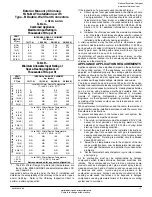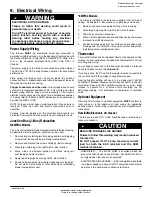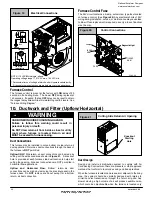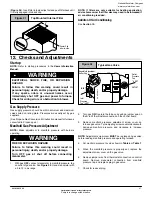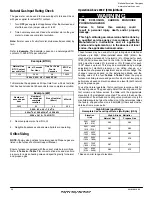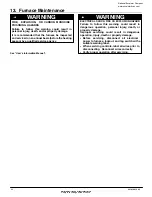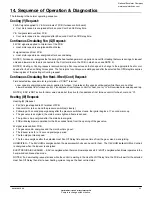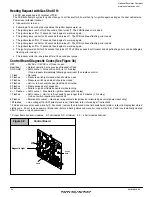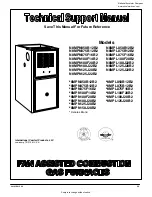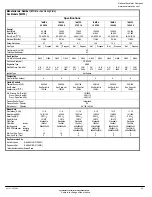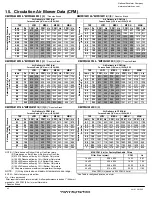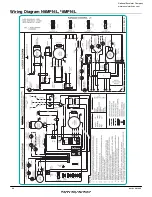
441 01 2613 05
31
Specifications are subject to change without notice
Air Temperature Rise Check
!
REDUCED FURNACE LIFE HAZARD
Failure to follow this caution may result in reduced
furnace life.
Use
ONLY
the blower motor speed taps insert
indicated in the
Circulation Air Blower Data
for
setting air temperature rise.
CAUTION
The blower speed
MUST
be set to give the correct air temperature
rise through the furnace as marked on the rating plate.
Temperature rise is the difference between supply and return air
temperatures.
To check temperature rise, use the following procedure:
1. Place thermometers in supply and return air registers as close
to furnace as possible, avoiding direct radiant heat from heat
exchangers.
2. Operate furnace for 10 minutes with all the registers and duct
dampers open by using a jumper wire on R to W thermostat
connections on the control board.
3. Take readings and compare with range specified on rating
plate.
4. If the air temperature rise is not in the correct range, the
blower speed must be changed. A higher blower speed will
lower the temperature rise. A lower blower speed will increase
the temperature rise.
5. Remove the jumper wire after the adjustments are complete.
Changing Blower Speed
ELECTRICAL SHOCK HAZARD
Failure to follow this warning could result in
personal injury, death and/or component damage.
Turn OFF power to furnace, lockout, and tag switch
with a suitable warning label before changing
speed taps.
!
WARNING
NOTE
: The speed taps that the manufacturer sets at the factory
for this furnace are based on a nominal 400 CFM per ton cooling
and the basic mid range on the temperature rise for heating.
Since the manufacturer cannot predict the static pressure
that will be applied to the furnace, it is the responsibility of the
installer dealer/contractor to select the proper speed tap
leads for the application when the furnace is installed.
If it is necessary to change speeds, refer to steps below.
1. Refer to
Furnace Wiring Diagram
for location of the heating
and cooling speed taps located on the electronic furnace
control as well as location of unused blower motor speed
leads. Use the chart (
Table 8
) to determine the blower motor
speed settings.
Table 8
Blower Speed Chart
Wire Color
Motor Speed
Black
High
Orange
*
Med
!
High
Blue
Med
!
Low
Red
Low
*
Med
!
High speed may not be provided on all models.
2. Change the heat or cool blower motor speed by removing the
motor speed lead from the “
Heat
” or “
Cool
” terminal and
replace it with the desired motor speed lead from the
“M1” or
“M2
” location. Connect the wire previously removed from the
“
Heat
” or “
Cool
” terminal to the vacated
“M1” or “M2
”
terminal.
3. If the same speed must be used for both heating and cooling,
remove the undesired motor speed lead from the
“Heat”
or
“Cool”
terminal and connect that lead to the open terminal at
“M1” or “M2
” location or tape off. Attach a jumper between
the
“Heat”
and
“Cool”
terminals and the remaining motor
speed lead.
Note:
When using the same speed on motors with (4) speed
leads, it will be necessary to tape off the terminal of the motor
speed lead removed from the
“Heat”
or
“Cool”
terminal with
electrical tape since an open terminal will not be available at
the
“M1” or “M2
” location.
Thoroughly check the system after modification to ensure the
proper operation of the circulating air blower in all modes of
operation.
Continuous-Fan Operation using “G”
Energizing the “G” terminal on the furnace control provides
continuous fan operation. This is done by connecting the G
terminal of the thermostat to the G terminal on the furnace control.
When the FAN switch is turned from auto to ON the fan will operate
continuously at “HEAT” speed. EAC will be energized in this
mode.
NOTE: In heating, the fan will turn off during furnace ignition and
warm up then restart at heating speed.
Hard Wired Continuous-Fan Operation
A terminal is provided on the furnace control board located in the
circulating air blower compartment for operation of the
continuous
!
fan option. This connection is intended for the low
speed motor tap, and has a lower contact rating (8 amps) than the
heat and cool taps. When the low speed blower lead is connected
to this terminal, this will provide low speed blower operation
whenever the other two speeds (
Heat
or
Cool
) are not energized.
EAC is not powered in this mode.
Thoroughly check the system after modification to ensure the
proper operation of the circulating air blower in all modes of
operation.
Separate speed selections for Heat, Cool, and
Continuous-Fan
Connect low speed lead from circulating air motor to the
“Cont”
t
erminal at the furnace control board. The appropriate motor leads
should already be connected to the
“Heat”
and
“Cool”
terminals.
Heating and Continuous-Fan Speed the Same
If it is necessary to operate the heating speed and continuous
!
fan
speed using the same blower speed, connect a jumper between
the “
Heat
” and “
Cont
” terminals on the furnace control board.
Note
: There should be only
ONE
motor lead going to the “
Heat
”
and “
Cont
” terminals.
National Excelsior Company
www.excelsiorhvac.com
Subject to change without notice.

